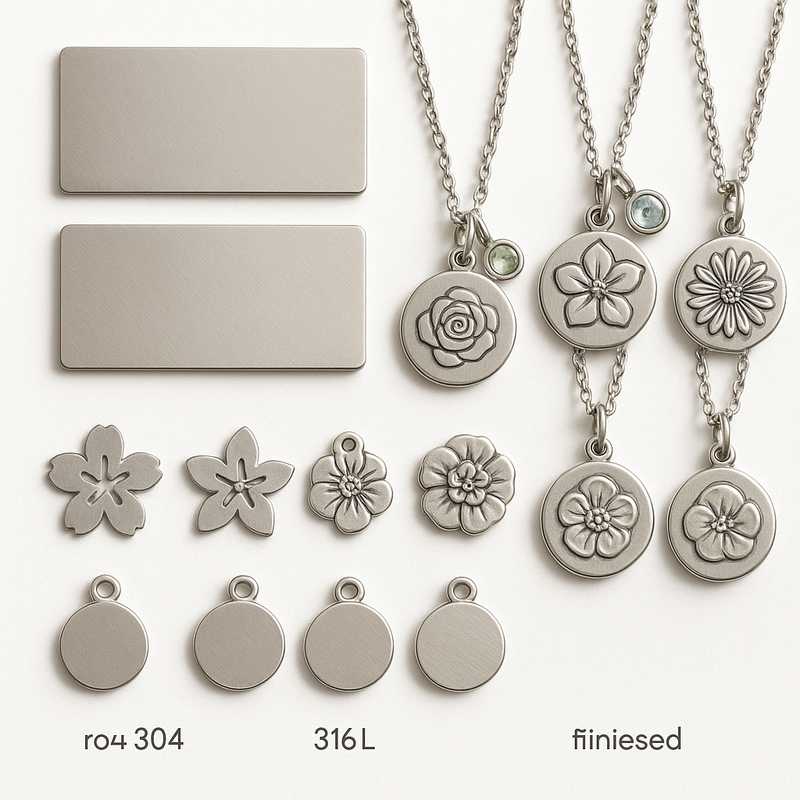Engineering Elegance: Materials & Methods for Custom Flower Charms

Unveiling 304 vs. 316L stainless steel, precision tech, and green processes in B2B charm necklace manufacturing
When it comes to B2B production of custom flower birthstone charm necklaces, materials and methods aren’t just background details—they define quality, longevity, and brand credibility. As consumer expectations rise, especially in the high-demand gift and personal jewelry segments, manufacturers must strike the balance between engineering precision and aesthetic finesse. This page explores the most critical differentiators for OEM and ODM buyers: the core material showdown between 304 and 316L stainless steel, high-efficiency technologies like laser cutting and hydraulic stamping, and sustainable production practices that speak to modern values.
The Stainless Steel Showdown: 304 vs. 316L in Charm Manufacturing
Not all stainless steels are created equal. In jewelry manufacturing, particularly in wearable art like custom flower birthstone charms, material choice isn’t cosmetic—it’s foundational. Here’s how 304 and 316L stainless steels stack up in terms of performance and practical application.
Corrosion Resistance and Environmental Exposure
304 stainless steel is widely used for general-purpose jewelry due to its strength, formability, and affordability. It performs well under normal conditions, offering solid resistance to oxidation and staining. However, it can show signs of wear or corrosion over time in high-salinity or humid environments.
316L stainless steel, on the other hand, contains molybdenum—an elemental upgrade that supercharges its corrosion resistance, especially against chlorides and marine exposure. This makes 316L the go-to choice for high-end charm necklaces destined for warm, coastal markets or wearers with sensitive skin.
Application Scenarios in OEM/ODM Production
- 304 Steel: Best for bulk fashion lines, seasonal releases, or promotional jewelry where cost control is key.
- 316L Steel: Ideal for premium collections, wellness jewelry (nickel-sensitive consumers), and export-grade goods facing stringent quality regulations in EU, US, or Japan.
Cost vs. Longevity
While 316L stainless steel can increase raw material costs by 10–15%, its enhanced longevity reduces returns and boosts brand reputation. Many top OEM clients now choose 316L exclusively for their signature birthstone lines, accepting slightly higher MOQs for better market differentiation.
Precision in Practice: Manufacturing Technologies that Matter
Jewelry is personal—but precision makes it possible. In the production of custom flower charms, advanced tools turn raw steel into refined miniatures of botanical beauty. Here’s a closer look at the technologies raising the bar.
Laser Cutting for Complex Petal Designs
High-precision fiber laser cutting allows for extremely fine details—down to 0.1 mm tolerances. This makes it possible to accurately render intricate petal contours, veining, or birth month flower silhouettes (e.g., snowdrop for January or chrysanthemum for November). It also reduces material waste and speeds up prototyping.
Hydraulic Stamping for Dimensional Relief
Flat isn’t always elegant. Hydraulic stamping presses metal into sculptural forms, creating dimensional charms with tactile appeal. This is particularly useful for layered effects, such as overlaying a blossom with a gemstone cradle or monogram plate. Unlike CNC, stamping is cost-efficient at scale.
Corrosion Etching and Pattern Engraving
Through controlled acid etching, subtle textures—like watermarks, sandblasting effects, or sunburst backgrounds—can be introduced without compromising structural integrity. This adds depth to the charm surface and creates micro-reflections that enhance perceived value.
Eco-Focused Engineering: Greener Methods for Modern Brands
In 2025, sustainability isn’t optional—it’s part of the spec sheet. For stainless steel charm necklaces, this means minimizing ecological impact across the manufacturing lifecycle. Here’s how responsible producers are staying ahead.
Electroplating with Reduced Toxic Load
Traditional plating processes involve heavy metals and cyanides, but modern alternatives are stepping up. Trivalent chromium plating (Cr3+) has replaced more hazardous hexavalent chromium (Cr6+), reducing toxicity without sacrificing sheen or durability. Meanwhile, water-based electrolytes are improving bath recyclability and worker safety.
Waste Recycling in Closed-Loop Systems
Top-tier workshops are implementing metal recovery units to reclaim stainless steel scrap and spent polishing agents. One OEM reported a 35% reduction in virgin steel purchases over 18 months through closed-loop metal reprocessing. This not only lowers costs but also positions the brand as authentically eco-conscious.
Energy-Efficient Machinery and Smart Monitoring
From servo-driven hydraulic presses to AI-optimized annealing kilns, energy savings are adding up. Smart monitors track machine idle times and energy spikes, automatically adjusting workflows to minimize consumption. The result: lower overheads and measurable green KPIs for enterprise buyers.
Case in Point: High-Volume ODM for a Luxury Eco-Brand
In 2024, a US-based premium lifestyle brand partnered with a Taiwanese OEM to launch a 12-piece birth flower charm line. They demanded:
- 316L stainless steel with zero nickel content
- Botanical laser etching unique to each flower
- Corrosion-etched matte finish with eco-plated gold rim
- Full traceability for green certification
The result? A product line with less than 1% return rate, full RoHS compliance, and strong sell-through in eco-boutiques across Canada, Germany, and Japan. Production waste was cut by 40% compared to the client’s previous supplier.
Conclusion: Why Material Mastery and Method Matter
Custom flower birthstone charm necklaces aren’t just seasonal trends—they’re storytelling tools, emotional gifts, and brand assets. For B2B buyers, the difference between 304 and 316L stainless steel, the decision to laser cut vs. hand carve, or the shift to green plating practices isn’t trivial—it defines whether your product stands out or falls short.
Ready to manufacture smarter, cleaner, and sharper? Choose a partner that aligns with your goals for quality, performance, and sustainability. Get in touch with our production consultants to explore tailored OEM/ODM options in stainless steel charm manufacturing. Let’s engineer elegance—without compromise.
